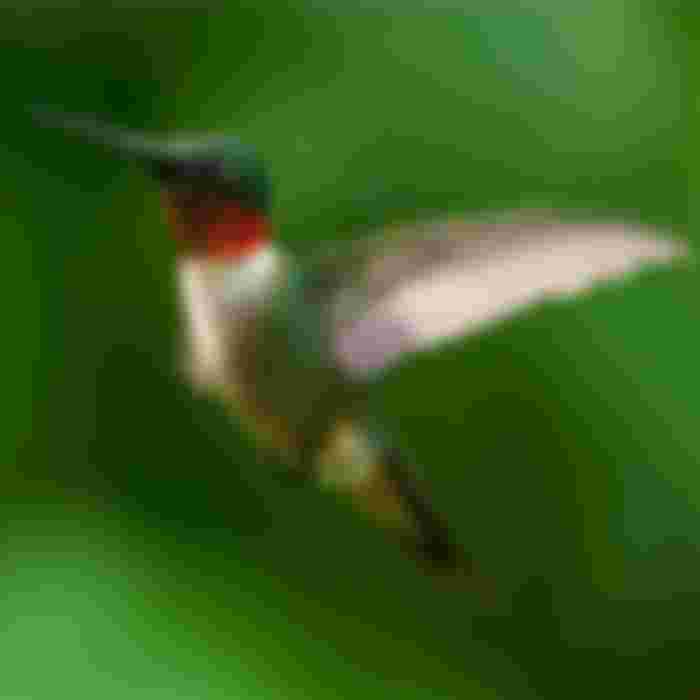Hummingbirds are birds native to the Americas and constituting the biological family Trochilidae. They are the smallest of birds, most species measuring 7.5–13 cm (3–5 in) in length. The smallest extant hummingbird species is the 5 cm (2.0 in) bee hummingbird, which weighs less than 2.0 g (0.07 oz). The largest hummingbird species is the 23 cm (9.1 in) giant hummingbird, weighing 18–24g (0.63–0.85 oz).

They are known as hummingbirds because of the humming sound created by their beating wings, which flap at high frequencies audible to humans. They hover in mid-air at rapid wing-flapping rates, which vary from around 12 beats per second in the largest species, to in excess of 80 in some of the smallest. Of those species that have been measured in wind tunnels, their top speeds exceed 15 m/s (54 km/h; 34 mph) and some species can dive at speeds in excess of 22 m/s (79 km/h; 49 mph).

Hummingbirds have the highest mass-specific metabolic rate of any homeothermic animal.[3] To conserve energy when food is scarce, and nightly when not foraging, they can go into torpor, a state similar to hibernation, slowing their metabolic rate to 1/15th of its normal rate.
Evolution
A map of the hummingbird family tree – reconstructed from analysis of 284 of the world's 338 known species – shows rapid diversification from 22 million years ago.[5] Hummingbirds fall into nine main clades, the topazes, hermits, mangoes, brilliants, coquettes, Patagona, mountain gems, bees, and emeralds, defining their relationship to nectar-bearing flowering plants and the birds' continued spread into new geographic areas.
While all hummingbirds depend on flower nectar to fuel their high metabolisms and hovering flight, coordinated changes in flower and bill shape stimulated the formation of new species of hummingbirds and plants. Due to this exceptional evolutionary pattern, as many as 140 hummingbird species can coexist in a specific region, such as the Andes range.

The hummingbird evolutionary tree shows ancestral hummingbirds splitting from insectivorous swifts (family Apodidae) and treeswifts (family Hemiprocnidae) about 42 million years ago, probably in Eurasia. One key evolutionary factor appears to have been an altered taste receptor that enabled hummingbirds to seek nectar.[9] By 22 million years ago the ancestral species of current hummingbirds became established in South America, where environmental conditions stimulated further diversification.
The Andes Mountains appear to be a particularly rich environment for hummingbird evolution because diversification occurred simultaneously with mountain uplift over the past 10 million years. Hummingbirds remain in dynamic diversification inhabiting ecological regions across South America, North America, and the Caribbean, indicating an enlarging evolutionary radiation.

Within the same geographic region, hummingbird clades co-evolved with nectar-bearing plant clades, affecting mechanisms of pollination.[10][11] The same is true for the sword-billed hummingbird (Ensifera ensifera), one of the morphologically most extreme species, and one of its main food plant clades (Passiflora section Tacsonia)
Sexual dimorphisms
Hummingbirds exhibit sexual size dimorphism according to Rensch's rule,[13] in which males are smaller than females in small species, and males are larger than females in large-bodied species.[14] The extent of this sexual size difference varies among clades of hummingbirds.[14][15] For example, the Mellisugini clade exhibits a large size dimorphism, with females being larger than males.[15] Conversely, the Lophomithini clade displays very little size dimorphism; males and females are similar in size.[15] Sexual dimorphisms in bill size and shape are also present between male and female hummingbirds,[15] where in many clades, females have longer, more curved bills favored for accessing nectar from tall flowers. For males and females of the same size, females will tend to have larger bills.
Sexual size and bill differences likely evolved due to constraints imposed by courtship because mating displays of male hummingbirds require complex aerial maneuvers. Males tend to be smaller than females, allowing conservation of energy to forage competitively and participate more frequently in courtship.Thus, sexual selection will favor smaller male hummingbirds.
Female hummingbirds tend to be larger, requiring more energy, with longer beaks that allow for more effective reach into crevices of tall flowers for nectar.[16] Thus females are better at foraging, acquiring flower nectar, and supporting the energy demands of their larger body size. Directional selection will thus favor the larger hummingbirds in terms of acquiring food.
Another evolutionary cause of this sexual bill dimorphism is that the selective forces from competition for nectar between the sexes of each species are what drive the sexual dimorphism. Depending on which sex holds territory in the species, it is advantageous for the other sex to have a longer bill and be able to feed on a wide variety of flowers, decreasing intraspecific competition. For example, in species of hummingbirds where males have longer bills, males do not hold a specific territory and have a lek mating system. In species where males have shorter bills than females, males defend their resources and therefore females must have a longer bill in order to feed from a broader range of flowers.



